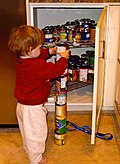
Autism is a disorder of neural development characterized by impaired social interaction, verbal and non-verbal communication, and by restricted and repetitive behavior. It is a difficult disorder to define because cases differ so greatly; however, there are some commonalities.[1] The diagnostic criteria require that symptoms become apparent before a child is three years old. Autism affects information processing in the brain by altering how nerve cells and their synapses connect and organize; how this occurs is not well understood. It is one of three recognized disorders in the autism spectrum (ASDs), the other two being Asperger syndrome, which lacks delays in cognitive development and language, and pervasive developmental disorder, not otherwise specified (commonly abbreviated as PDD-NOS), which is diagnosed when the full set of criteria for autism or Asperger syndrome are not met. (Full article...)
- ^ Pinel, J. P. J. (2011). Biopsychology, 8th Edition. Boston: Pearson Education.